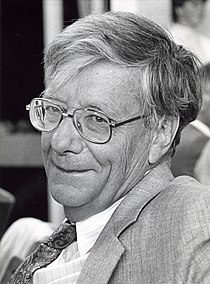
Back نيكولاس بلومبرجن Arabic نيكولاس بلومبرجن ARZ Nikolas Blumberqen Azerbaijani نیکولاس بلومبرگر AZB Нікалас Бломберген Byelorussian Николас Блумберген Bulgarian নিকোলাস ব্লোমবের্গেন Bengali/Bangla Nicolaas Bloembergen Catalan Nicolaas Bloembergen Czech Nicolaas Bloembergen Danish
Nicolaas Bloembergen | |
|---|---|
 Bloembergen in 1981 | |
| Born | March 11, 1920 |
| Died | September 5, 2017 (aged 97) |
| Citizenship | Netherlands United States |
| Alma mater | Leiden University Utrecht University |
| Known for | Laser spectroscopy Non-linear optics Motional narrowing Photon upconversion Atomic line filter Second-harmonic generation BPP theory |
| Spouse |
Huberta Deliana Brink
(m. 1950) |
| Awards |
|
| Scientific career | |
| Fields | Applied physics |
| Institutions | University of Arizona Harvard University |
| Doctoral advisor | Cornelis Jacobus Gorter |
| Other academic advisors | Edward Purcell |
| Doctoral students | Peter Pershan Yuen-Ron Shen Eli Yablonovitch |
Nicolaas Bloembergen (March 11, 1920 – September 5, 2017) was a Dutch-American physicist and Nobel laureate, recognized for his work in developing driving principles behind nonlinear optics for laser spectroscopy.[1] During his career, he was a professor at Harvard University and later at the University of Arizona and at Leiden University in 1973 (as Lorentz Professor).
Bloembergen shared the 1981 Nobel Prize in Physics along with Arthur Schawlow and Kai Siegbahn because their work "has had a profound effect on our present knowledge of the constitution of matter" through the use of laser spectroscopy. In particular, Bloembergen was singled out because he "founded a new field of science we now call non-linear optics" by mixing "two or more beams of laser light... in order to produce laser light of a different wave length" and thus significantly broaden the laser spectroscopy frequency band.[2]
- ^ "Nobelprijswinnaar Nicolaas Bloembergen (97) overleden". Universiteit Leiden. September 6, 2017. Archived from the original on September 8, 2017. Retrieved May 3, 2018.
- ^ Cite error: The named reference
Nobelwas invoked but never defined (see the help page).
© MMXXIII Rich X Search. We shall prevail. All rights reserved. Rich X Search